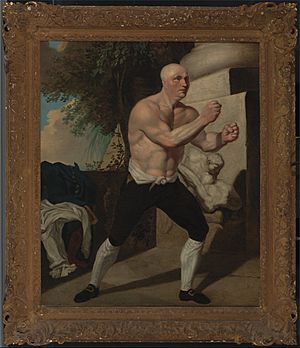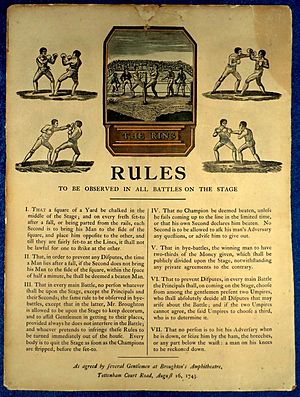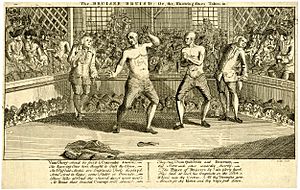Jack Broughton facts for kids
John "Jack" Broughton (born around 1703 – died 8 January 1789) was a famous English bare-knuckle boxer. He was the first person to create a clear set of rules for boxing matches. Before him, boxing rules were very loose and changed a lot from one fight to another. His seven rules for boxing were used for almost 100 years. They were later replaced by the London Prize Ring rules in 1838.
Early Life and Start in Boxing
Not much is known for sure about John Broughton's early life. He was born around 1703. Some say he was from London, while others believe he was a farmer's son from Gloucestershire.
In May 1723, Broughton became an apprentice to a waterman on the River Thames. Watermen were people who operated boats on the river. On 1 August 1730, Broughton won a special rowing race for watermen. At that time, he worked near Hungerford Market in London.
Broughton's first fights might have been against other watermen. One story says he won a fight after an argument. A promotion for one of his fights in 1750 claimed he had not lost a fight for 24 years. This means his first fights probably happened around 1726.
A Champion Boxer
By 1730, Broughton was fighting in professional boxing matches. These fights were advertised in London newspapers. He often fought at popular boxing venues. He had many fights against the same opponents. For example, he fought Thomas Allen four times between 1730 and 1734. He also fought George Stephenson three times starting in 1738.
Broughton opened his own boxing venue in Oxford Road on 13 March 1743. People could pay a small fee to watch boxing displays. Broughton wanted a place where only skilled fighters would compete. He also hosted animal shows like bear-baiting.
On 16 August 1743, he wrote the first official rules for boxing. These rules said that a round would last until a fighter fell down. There would then be a 30-second break between rounds. These rules were used widely in boxing until 1838.
Broughton was also a King's Body Guard. This meant he was part of the King's personal guard.
In 1747, Broughton opened a boxing school in Haymarket. At this school, men could learn boxing while wearing "mufflers." These were an early type of boxing glove. They helped protect fighters from injuries. Some people believe Broughton invented boxing gloves because he used these mufflers. However, gloves did not become common in professional fights until much later.
On 11 April 1750, Broughton fought Jack Slack, a butcher from Norfolk. This fight happened because of a personal disagreement. Two minutes into the fight, Slack landed a punch that blinded Broughton. After 14 minutes, Broughton had to stop fighting because he could not see. The Duke of Cumberland, who supported Broughton, reportedly lost a lot of money on this fight.
Broughton stopped boxing after this defeat. However, he continued to run his boxing venue until 1753 or 1754. After that, he started an antiques business.
Later Years and Legacy
Broughton kept teaching boxing until 1787, when he was in his eighties. He was married to a woman named Elizabeth.
John Broughton died on 8 January 1789, at his home in Lambeth. He left a large sum of money to his niece. He was buried at Westminster Abbey. He wanted his headstone to say "Champion of England." The church leader at the time did not agree, so the space was left blank. In 1988, Broughton's wish was finally granted. His headstone now reads "Champion of England, Pugilist."

Broughton was a famous figure in his time. He appeared in 18th-century art and books. Artists like John Ellys and John Hamilton Mortimer painted his portrait. He also served as a model for a statue of Hercules. Writers like Paul Whitehead and Henry Fielding mentioned him in their works. Fielding even joked about Broughton's boxing school and his invention of "muffler" boxing gloves.
John Broughton is remembered as a pioneer of boxing. He was one of the first people to be included in the International Boxing Hall of Fame.
See also
 In Spanish: Jack Broughton para niños
In Spanish: Jack Broughton para niños




